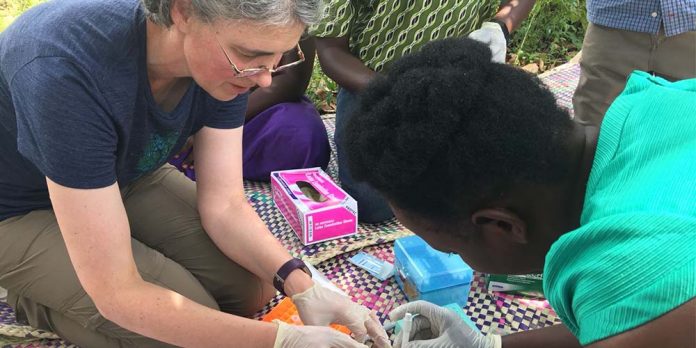Crop success for subsistence African farmers can mean the difference between life and death so waiting six months for a test to identify a disease in their plants is simply too little, too late. But a device developed by Otago University researchers is cutting that to hours. Dr Jo Stanton has seen her science in action in Africa and told Richard Rennie about it.
A small, hand-held device for farmers diagnose diseases is being developed by researchers at Otago University.
It can be used to detect and name diseases in plants and animals and might also aid in the fight against antibiotic resistance.
Researcher Dr Jo Stanton and her team hope the device, being developed with subsistence farmers in Africa, will be ready in two years.
In what is a world first, the research team has used it to diagnose, via genomic sequencing, plant diseases affecting African farm crop.
The team worked in Kenya, Tanzania and Uganda identifying viruses affecting the valuable cassava crop.
Cassava, a South American shrub, produces a starchy vegetable root similar to a potato vulnerable to viral pathogens that can wipe out entire plantations.
It is a vital staple crop for 800 million people but its supply is constantly threatened by the spread of viruses in countries where food surpluses are rare and crop failure can be catastrophic.
Stanton’s August African visit provided the proof of the concept genomic sequencing can be done in hours rather than the six-month wait farmers have had when diagnosing an unknown pest or disease.
“We took hand-held molecular diagnostic devices that included the PDQeX from New Zealand company ZyGEM that permits on-site DNA extraction. This was coupled to a United Kingdom-developed mini supercomputer for analysis and a portable DNA sequencer.”
The Kiwi designed PDQeX machine’s title stands for Pretty Damn Quick Extraction, a humorous but proud acronym and tribute to the machine’s game changing capability.
The equipment enables DNA sequencing and interpretation in real time.
“What really fascinated us was the interest of the African farmers.
“Molecular biology is not a spectator sport but they stayed around for the full analysis time – they did not understand exactly what it was doing but they did understand the importance of it and appreciate just how valuable and timely this information would be to them.”
The trial farm for her genomic sequencing visit is 1400km from the former Tanzanian capital of Dar es Salaam.
Last year a farm nearer the city had already benefited from the technology’s timely results.
“This woman’s crop – and the majority of farmers are women – had been affected by a virus.
“The sequencing identified the virus and it was possible to rip out the infected crop and replant with a resistant one within the season.
“It meant she went from a zero yield crop to a 35t/ha crop.
“She had never been in a situation where she had a surplus before.”
She was part of a cassava growing group comprising five women farmers and Stanton estimates the timely resowing of the crop affected the lives of 3000 people in that district.
“Personally, this is very rewarding work.
“It has been a complete privilege to be on the ground and see the outcome of our work in such a positive way.”
Ultimately the researchers want a hand held device that encases the three separate components they used in the proof of concept stage.
But in terms of product design Africa brings its own challenges.
There is no mains power in rural areas, no internet connectivity, roads are difficult and distances great.
“And it also needs to be farmer-friendly in terms of how it is used.
“It is no good if it requires the likes of a molecular biologist to be around to operate it and interpret the results.”
That brings the further challenge of developing software for decision-making based on data interpretation.
The self-contained device is likely to be a couple of years away and represents a huge advance from technology that used to require an entire laboratory and cooling and heating equipment to deliver the same results.
Funding has been secured through the Ministry of Business, Innovation and Employment’s Endeavour Research Fund to take it to this stage.
The device could also be useful for NZ farmers.
“Imagine if we had had such technology when Psa broke out.
“It could have helped identify very early on what orchards were infected and, just as importantly, what ones weren’t and contained it very quickly.”
She is uncertain if it would have identified M bovis earlier, given it was not looked for until much later in its spread, but it would help contain its further spread with its rapid test results done and delivered on farms, compared to sending samples to distant labs.
Stanton can see the day when such a piece of kit is standard issue for vets, council staff and lab technicians.
“It could also be used to identify antibiotic resistance in animals and help tailor the right treatments and slow the spread of resistance development.”
Source:https://farmersweekly.co.nz





